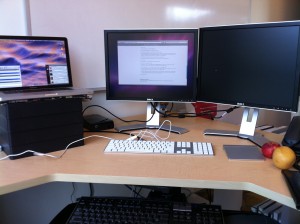I’ve been on vacation (as evinced by my whinging about trying to make a purchase overseas, as well as my administrivia). I left the office on December 14, and today is my first day back in the office. After being gone for nearly a month, I wasn’t sure what to think about getting back in the saddle. On one hand, being out for that long is all but guaranteed to lead to frightful numbers of unread email. But on the other hand, VMware shuts down for the week before the New Year. And I’m the newbie on the team anyway (I joined VMware on November 8).
When I got in this morning, I found that I had 345 emails waiting for me in my Outlook:Mac inbox. Today’s task has been to go through them. A couple of years ago, I wrote a post for Mac Mojo about how to find your way out from all that email. It was focused on Entourage, as well as my email usage at the time. As I went through my mail, I thought about how my strategy differs now.
Pre-trip, I still set my OOF message (and yes, I do still think of it as OOF1) even though VMware’s terminology is PTO2. I created an event named “vacation” on my calendar, which shows my status as “out of office”. During my trip, I didn’t check my email at all (!!).
After my trip, though, I find that my strategy has changed. I used to look for high-priority and flagged messages first. I don’t seem to get any messages that are marked as high-priority, nor ones that are flagged. I’m not sure if that’s a reflection of VMware culture, or simply an indication that I’m still a newbie and thus not deeply involved in matters yet. I did deal with calendar invites, but that was quick and painless. It was so quick and painless that it didn’t really feel like a separate step.
Next up, I did something that I haven’t done before: I did some keyword search. For example, I searched on “PTO” to find messages from others on my team who were also taking time off. I glanced quickly over them to see if anyone was still out of the office, and then was able to quickly delete a bunch of mail. The goal of this step is to quickly get rid of stuff that I know isn’t relevant any longer. While this might not sound like a big deal, it makes it easier to focus on the mail that does matter.
Then I sorted by sender. Mails from my manager (and her manager) are the ones I read first. Some of those were dealt with immediately, some were read and deleted, some will need further action on my part. The goal was to identify either low-hanging fruit (to get it done and out of my mailbox), or to identify high-priority things that I need to deal with immediately. The next tier of email are from people on the team for my first major research project here, which kicks off in a couple of weeks. The goal is the same as that for my manager: handle the high-priority stuff, delete the stuff that I don’t need, create to-dos for stuff that will need further attention from me.
Then I go back to conversation view. I have to admit that when I resisted using conversation view in Outlook for quite some time, and it took the PM who was responsible for that feature to come to me and ask me to use it3 But now, I find conversation view to be indispensable, and so much easier to use than the implementation in Entourage:Mac 2008. It’s a lot faster to identify threads of conversation that I don’t need. The preview pane shows me the first line of each mail in the conversation, so it’s very quick to blast through an entire conversation and decide what action I need to take. (Confidential to Ryan: Thanks! I owe you one.)
I haven’t done a category search yet. Being new to the team, my category list hasn’t evolved like it was when I was at MacBU. There, I had categories for each application team, and I could sort on category because I knew that I was more interested in mails about PowerPoint and Outlook than I was about Word and Excel. Here, I don’t yet know the full extent of what I’ll work on, so I don’t have a big category list yet. My category list will continue to evolve, since it’s just too useful of a tool for me to give up. But for now, I can’t use it as a filtering mechanism.
So now it’s time to get through the rest of my inbox. In an attempt to make this feel more manageable, I’ve been doing it in 15-minute increments. I’m starting with the most recent and working my way through. The goal now is to only touch any given email once. When my 15 minutes is done, I take an email break: knock something off of my to-do list, have a conversation with someone, or just walk to the kitchen to get a fresh glass of water4. I’m sure that I won’t get to Inbox Zero today, but I’m going to have made a lot of progress towards that goal.
- This is an elderly term meaning Out Of Facilities, even though the menu has long been changed to “Out of Office”. ↩
- Paid Time Off ↩
- I’m a big believer in eating your own dogfood. He knew that, since he knew how many bugs I’d submitted. So he asked me to dogfood that particular feature. I agreed, reluctantly. ↩
- Email is dehydrating! ↩
